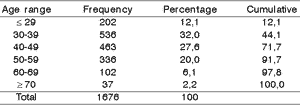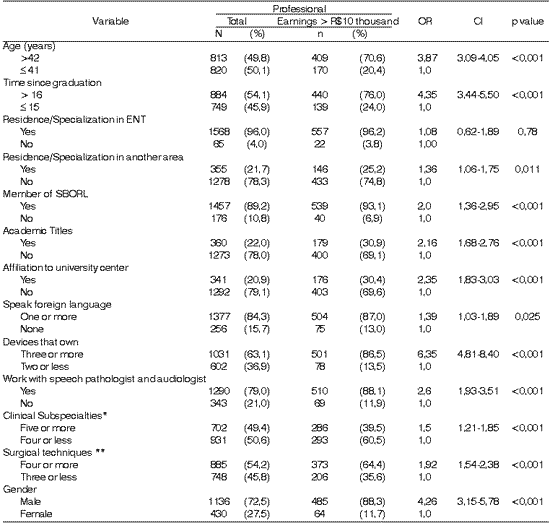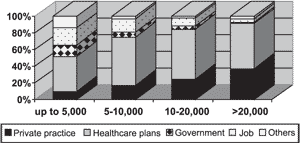INTRODUCTIONThe research study Profile of Brazilian Physician, conducted in the 90's by Fundação Oswaldo Cruz (FIOCRUZ) together with the Federal Medical Board in Brazil was one of the pioneers in the country and provided significant data for the category in Brazil.
However, it does not allow systematic analysis of the medical specialties, becoming necessary the development of further studies. Some societies have already conducted such studies 1.
In 2002, the Brazilian Census on Otorhinolaryngology was completed, prepared and published by the Brazilian Society of Otorhinolaryngology (SBORL) and disseminated during the 36º Congresso Brasileiro de Otorrinolaringologia, held in November 2000 in the city of Florianópolis. In the census, by active search, the study managed to register at SBORL 5,830 professionals, members and non-members. Next, the professionals were separated by region, state and Brazilian municipalities (5,507), detecting the proportion between the population and the number of Otorhinolaryngologists. The census enabled an exact mapping of the area, highlighting the regions of greater concentration and those that needed professionals.
Next, upon request of the Board of Directors of SBORL, the profile of the Brazilian Otorhinolaryngologist was conducted. Using some of the data obtained in the profile, the present study conducted an analysis of Otorhinolaryngologists earnings and the variables that may influence them.
MATERIAL AND METHODWe sent questionnaires to all the 5,830 physicians registered at SBORL 2, in August 2002 with an explanation letter addressing the objectives and the importance of the study and ensuring confidentiality of information.
All questionnaires included a postal paid response envelope.
In the study we investigated earnings of Otorhinolaryngologists, how they were comprised and the associated variables. The variable earning and other continuous variables were separated using as a criterion the cut-off point close to the median (percentile 50). For example: the distribution of the variable age shows that 50% of the professionals were aged 41 years or less. Therefore, it was the cut-off point of the distribution.
Other variables were distributed as well according to the presence or absence of the event. For example, the professionals that had further studies (master, doctorate degrees) were grouped and separated from those that did not have it.
Data were stored and analyzed in the software EpiInfo 6.043. We used a chi-square test to compare proportion 4, stratification adjustment and Maentel-Haenszel5 procedure and multivariate logistic regression 6. The latter was conducted using software EpiInfo 20027. The level of statistical significance was considered as 0.05.
Table 1. Distribution by geographical region of the total number of professionals and returned questionnaires.

p=0,40; c2=4,05
Table 2. Distribution of Otorhinolaryngologists by age range.

Table 3. Distribution of Otorhinolaryngologists by gender and men age.

*p<0,001
Table 4. Earning ranges of Otorhinolaryngologists.

Table 5. Univariate analysis with divided variables.

* Head and Neck, Laryngology, Otology, Pediatric ENT, Rhinology
** Head and neck, skull base, cosmetic, laryngology, rhinology and pediatric.
Table 6. Variables of the final logistic regression model.

Table 7. Distribution of professionals by gender and surgical practice.

p<0.001; OR=3.26; CI 95% = 2.15-4.93

Figure 1. Earning composition of Otorhinolaryngologists by earning ranges.
SBORL received back 1,636 questionnaires. Comparing the proportion of received questionnaires and the total number of Otorhinolaryngologists, grouped by geographical region, we concluded that there was no difference in the distribution (p=0.40). Therefore, we assumed that the distribution by geographical region of the total existing professionals and the professionals that responded to the questionnaire was similar (Table 1).
The Otorhinolaryngologists are young: approximately half of the professionals are less than 40 years and about 70% are less than 50 years of age (Table 2). The mean age was 42.8 years. The oldest professional was 84 years of age.
Other specialties present more marked professional rejuvenation. Pediatricians aged less than 50 years of amount to 85% of the category 1.
The introduction of women in the market place was more marked as of the 70's and beginning of the 80's, leading to a female trend of the profession, and in some specialties about 60% of the representatives are women (Machado, 2002). However, in Otorhinolaryngology, male professionals are still more predominant (70%). This female trend can be confirmed by the younger age of the female professionals as opposed to the mean age of male professionals, with statistically significant difference (Table 3).
The distribution of Otorhinolaryngologists according to monthly earning range is shown in Table 4. We observed that over 60% of the Otorhinolaryngologists are paid less than R$10,000 monthly.
The origin of earnings (private practice, healthcare plans, government services, employment, others) varies according to the earning range of professionals (Figure 1).
In order to allow identification of the association between the other variables of the questionnaire and the earning range, it was divided in order to facilitate analyses: the first level comprised 1,054 professionals (63.1%) that were paid less than R$10,000 monthly and the second level had 579 professionals (34.6%) paid over R$10,000. The professionals who did not inform the level of earnings were not included in the analysis.
In Table 5 we can see the distribution of the other variables of the questionnaire between 1,676 professionals (total column) and among professionals with earnings equal or greater than R$10,000 every month.
We observed that only the variable residence/specialization in the area was not statistically associated with the variable earnings. It was probably related to the high number of professionals that have this differential in the two groups of earnings.
Despite the fact that all other variables had statistically significant associations with the variable earnings, some associations did not present any cause-effect relation, meaning or possibility of rational explanation.
For example, the fact that being a member of SBORL increases the likelihood of a professional to 100% (OR = 2.0) of having earnings greater than 10,000 does not seem to be cause-effect related. The fact that a professional is a SBORL member can in fact reflect the involvement of the professional in his practice and updating, whereas a non-member professional would be less active.
A similar fact was observed in the association of the variable "able to speak one or more foreign languages" and "work with speech pathologist".
Other variables presented association between themselves and the variable earnings, which can add some confusion to the interpretation. For example, both the variable age and time since graduation were associated with professional earnings, that is, the greater the time in the profession or the older the professional, the greater the earnings. However, it is evident that those two variables are also correlated, that is, the older the age, the longer the time in the profession. Therefore, between the two, time since graduation is the most important one, since some professionals could have graduated at an older age.
Similarly, we could observe the behavior between academic titles and affiliation to a university center. It is known among professionals in the university life that stimulation and even requirement for academic titles are more marked.
A model of multivariate logistic regression with Epi-Info 2002 was created, considering as response variable the earnings, as indication variable the variables gender, residence/specialization in other areas, academic titles, affiliation to a university center, classified as distribution, and the variables time since graduation, number of devices that owns, number of clinical and surgical subspecialties in which is proficient, as continuous variables.
The final model, with the variables presenting statistically significant difference with earnings, is seen in Table 6.
We also tested for the presence of interaction between time since graduation and other indication variables, since the greater the time since graduation, the greater the possibility of the professional having more devices, clinical and surgical skills, having attended residence/specialization, being affiliated to a university center and having academic titles. There was no statistically significant difference between time since graduation and those variables.
Using the direct adjustment model by stratification and Maentel-Haenszel procedure, the variable time since graduation was divided into 6 categories: 0-5 years, 6-10 years, 11-15 years, 16-20 years, 21-30 years and ³ 31 years, being compared to gender distribution. It was concluded that there is no interaction between gender and time since graduation and earnings, that is, both female gender and time since graduation influence earnings independently. Therefore, the likelihood of a female professional having lower earnings is practically the same regardless of how long she has been graduated. And sine these variables were independent, a professional with less time since graduation is likely to have lower earnings than a female professional who has been graduated longer. This test showed, thus, that the reason why professionals who have lower chances of earnings more than 10,000 was not related to time since graduation, despite the fact that it had been shown that they were younger.
Therefore, among the variables initially included in the model, the variables residence/specialization in another area, academic titles, and number of clinical subspecialties were not associated with earnings of professionals after adjustment by the remaining variables.
The final equation predicted the possibility of specific professionals having earnings greater than 10,000, given by the following equation: exponential (number of devices x 0.4487 + number of surgical skills x 0.3427 + gender x 0.7637 + years since graduation x 0.0650 + affiliation to university center x 0.3639).
Therefore, a professional who has four pieces of devices, two surgical skills, male, 20 years since graduation and is affiliated to a university center (exponential [4x0.4487 + 2x0.3427 + 1x0.7637 + 20x0.0650 + 0x0.3639]) has exponential of 4.4839 more chances of having earnings greater than 10,000 than a professional who has all indicators as null (no devices, no surgical skills, female gender, no time since graduation and no affiliation to university center).
The odds ratio in Table 6 shows how greater is the chance of a professional compared to another one without that characteristics when all the other variables are the same between them. For example, a professional who has affiliation to a university center has 1.4 times more likelihood (40% more) of having earnings greater than 10,000 than a professional who has no university center affiliation when all the other variables are the same.
The explanation for the association of variables number of devices, number of surgical skills and time since graduation can be easily understood by the direct correlation between compensation and the two first ones and by greater number of clients (job) provided by the longer period since graduation.
The variable affiliation to a university center demonstrates an association between more frequent updating, interaction with professionals of the same and other specialties, among others.
The variable gender demonstrates that female professionals are less likely to have greater earnings than 10,000 monthly. It confirms the tradition that women are less directly involved with the professional activity because they are involved with family and home issues. Another explanation can be the fact that women, even in different professions, are paid less than men, for the same activity and workload. The first explanation can be confirmed with data from table 7, which demonstrated that a female professional has 3.26 more changes (226%) of not performing a surgery than a male professional. The time since graduation is not an explanation for this fact, since it was demonstrated that the time since graduation and gender are independent variables (Table 6).
CONCLUSIONSIn the analysis of the Otorhinolaryngology Brazilian profile, considering compensation, we could conclude that: a male professional who has university affiliation, has good surgical skills, owns devices and has been graduated long has more chances of making over 10,000 monthly.
REFERENCES 1. Machado MH, Vaz ES. Perfil dos Pediatras no Brasil: relatório final (Brasil e Grandes Regiões). Rio de Janeiro, Sociedade Brasileira de Pediatria: 2001;5-24.
2. Sociedade Brasileira de Otorrinolaringologia. Censo 2002.
3. Dean AG, Dean JA, Coloumbier D, Burton AH, Brendel KA, Smith DC. Epi Info, version 6.04: a word processing, database, and statistics program for public health on microcomputers. Centers for Disease Control and Prevention - World Health Organization; 1996.
4. Soares JF, Siqueira AL. Introdução à Estatística Médica. 1ª edição. Belo Horizonte: Departamento de Estatística - UFMG; 1999.
5. Kahn HA, Sempos CT. Statistical Methos in Epidemiology. New York: Oxford University Press; 1989.
6. Schlesselman, JJ. Case-Control Studies: Design, Conduct and Analysis. New York: Oxford University Press; 1982.
7. Dean AG, Arner TG, Sangam S, Sunki GG, Friedman R, Lantinga M, Zubieta JC, Sullivan KM, Brendel KA, Gao Z, Fontaine N, Shu M, Fuller G. Epi Info 2002, a database and statistics program for public health professionals for use on Windows 95, 98, ME, NT, 2000 and XP computers. Centers for Disease Control and Prevention, Atlanta, Georgia, USA, 2002.
1 Joint Professor, Department of Ophthalmology, Otorhinolaryngology and Speech and Language Pathology and Audiology, Medical School,
Federal University of Minas Gerais - UFMG. Vice-President of SBORL-Regional Office 5 (DF, GO, MT, MS, MG).
2 Associate Professor, Department of Pediatric Otorhinolaryngology, UNIFESP - Escola Paulista de Medicina. Ph.D., Full Professor, UNIFESP. President of SBORL 2001-2002.
3 Joint Professor, Department of Ophthalmology, Otorhinolaryngology and Speech and Language Pathology and Audiology,
Medical School, Federal University of Minas Gerais.
4 Master in Pediatrics. Resident Physician in Nephrology, UFMG.
Address correspondence to: Roberto Guimarães - Av. Pasteur 88, 4º andar, Funcionários Belo Horizonte MG
Tel (55 31) 3222-2891 - Fax (55 31) 3222-2891 - E-mail: rguimaraes@medicina.ufmg.br
Preliminary data were reported at Congresso Brasileiro de Otorrinolaringologia.
Partially sponsored by the Brazilian Society of Otorhinolaryngology - SBORL.
Article submitted on January 10, 2003. Article accepted on April 03, 2003.


